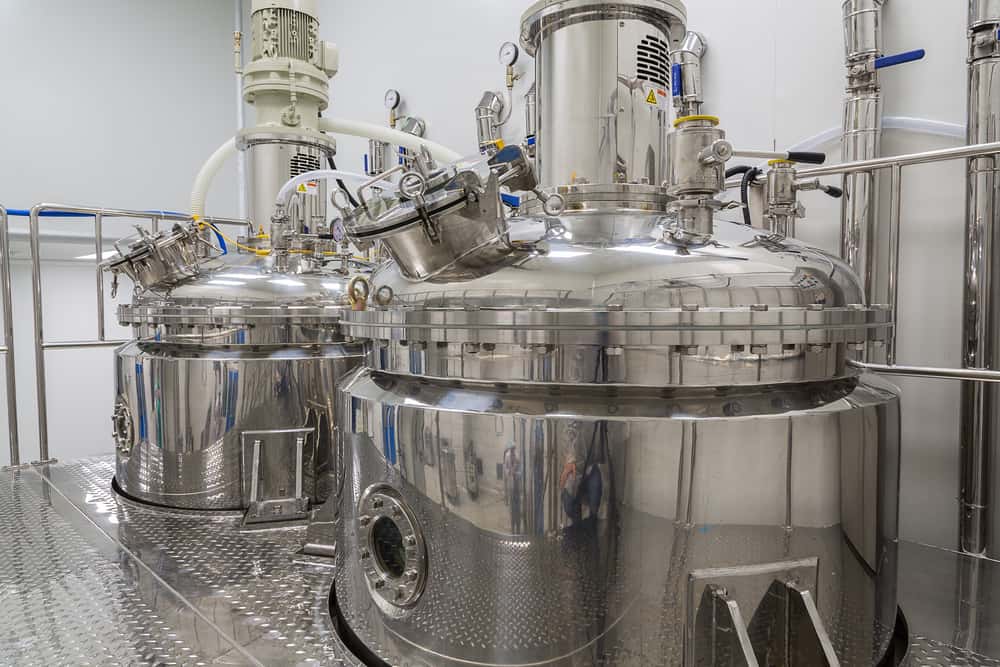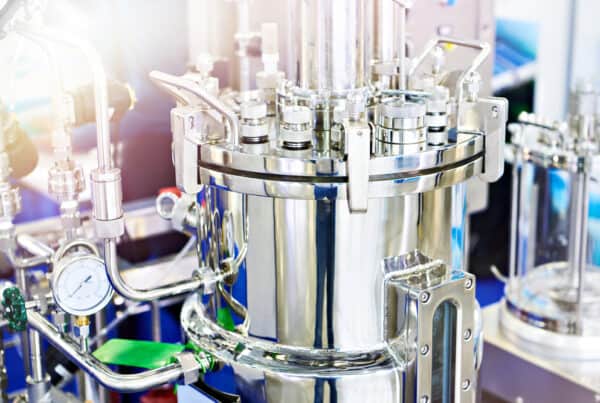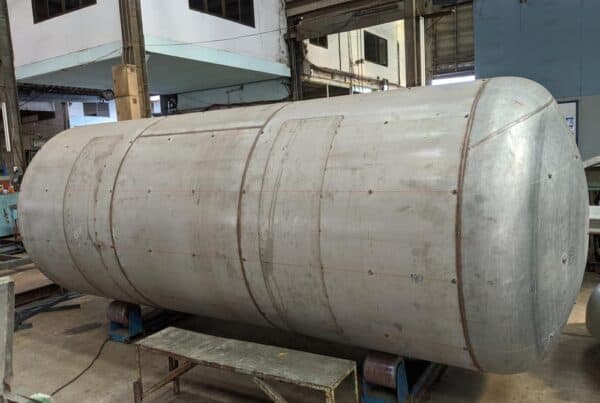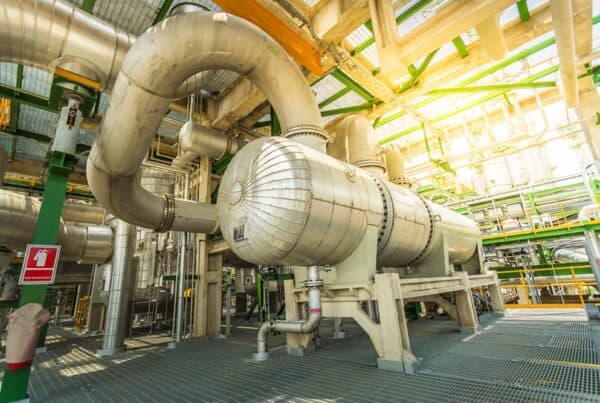
Pressure vessels have been around since the dawn of the industrial revolution. They can be used to store a higher volume of products than would be possible at normal atmospheric pressure, and since pressurization lowers boiling points, pressure vessels can also be used to process—cook—products more quickly or for a lower energy cost than would be possible otherwise. They are used in food, pharmaceutical, and chemical processing and in nuclear power both to generate power and to store liquids and gasses.
With such a diverse range of applications, the types of pressure vessels in use and the types of welding used in pressure vessels are incredibly diverse. The main commonality of pressure vessels is that they store large amounts of potential energy. A flaw or weak point in a vessel can cause the vessel to fail and release all of its energy at once in an explosion. As a result, it is important that pressure vessel welds be reliable and free of defects. The type of welding used to create a pressure vessel will be determined by the purpose of that pressure vessel.
Considerations for the Welding of Pressure Vessels
The chief consideration for welding pressure vessels is containing the pressurized contents. There is a long history of poorly built or poorly maintained pressure vessels experiencing a loss of containment and a resulting explosion.
Pressure vessel explosions are commonly thought to be a problem of the early industrial period, but they still occur regularly. Along with other disasters, the year 2020 has so far seen an explosion at a paper mill plant as well as a fatal explosion during the testing of a high-pressure guacamole maker. These incidents neatly underline the importance of quality welding.
Of the accidents mentioned above, the guacamole maker is likely to have been built following more stringent requirements. It would have been designed and constructed to keep the food inside free of industrial contaminants as well as to contain pressures. This would have limited the welding processes that could be used to those processes whose final welds can meet sanitary requirements for food. The biopharmaceutical industry and the semiconductor industry have similar cleanliness requirements that limit the types of welding used in pressure vessels built for those industries.
The Types of Welding Used in Pressure Vessels
Pressure vessels are almost always spherical or cylindrical, as this shape has no corners that could form stress points in the structure. To contain high-pressure products, pressure vessels are almost always built using metal 3 millimeters (about ⅛ inch) or more in thickness.
The edges of the plates used to build a pressure vessel are usually machined to create an angled bevel that allows the root pass of the weld to fully penetrate through the joint. When two of the component plates are situated side by side they will form a deep v-shaped or u-shaped groove. Once the root pass connects the two plates, subsequent passes will fill in this groove with metal, resulting in a smooth, continuous expanse of uniform or very nearly uniform metal. This is much the same welding process as that used in big bore pipe welding and the narrow groove welding process. Familiarity with those two types of welding can give welders and weld supervisors a good idea of how to weld pressure vessels.
The following types of welding are used to weld pressure vessel joints:
- Shielded Metal Arc Welding (SMAW): This welding process uses a flux-coated consumable electrode. This is often thought of as the default form of arc welding. It is highly portable and the equipment is inexpensive and widely available. However, it requires a high degree of skill and the quality of the resulting welds is dependent on the skill of the welder.
- Flux-Core Arc Welding (FCAW): This method uses a consumable wire-fed electrode with a core of flux. It is similar to SMAW in weld formation, but, due to the continuous wire feed, requires less skill to operate.
- Gas Metal Arc Welding (GMAW): GMAW involves welding using a continuous wire-fed electrode and inert shielding gas. It is one of the easiest welding processes to perform and makes welds that are cleaner than SMAW or FCAW. However, it is known to suffer from unpredictable fusion errors that don’t occur with the processes above.
- Gas Tungsten Arc Welding (GTAW): This method uses a tungsten electrode and inert shielding gas. It produces very clean welds with excellent fusion and penetration, but it is a slow process and difficult to master. This makes it a challenge to fill the volume required to perform a pressure vessel weld.
- Submerged Arc Welding (SAW): In SAW, the weldment is submerged in flux to shield it from oxygen and other gases in the atmosphere. It is a clean welding process with a high rate of deposition; however, it is not a portable, field-ready process.
Of the types of welding used in pressure vessels, the one chosen for a specific project should suit the needs of the product the pressure vessel will store or produce and the pressure that the product will be kept at. In the oil industry, pressure vessels are kept at relatively low pressure, and while corrosion can be an issue, sanitary considerations are not. As a result, quicker and more expedient processes like SMAW and FCAW are frequently used.
In higher specification projects with higher pressures, welding processes that render more consistent results, like GMAW or SMAW, are more likely to be used. In industries where both pressure and sanitation are a major concern, the root pass—which will be in contact with the product—is very likely to be welded using GTAW, as it provides a far cleaner and smoother weld than any other type of welding. Given the amount of welding that a pressure vessel requires, however, this is likely to be quite time-consuming if done manually. Mechanized welding processes like orbital welding can help increase the speed of GTAW welding used in pressure vessels.
Using Orbital Welding to Weld Pressure Vessels
Orbital welding was developed due to the need to create high-quality welds on hydraulic and aviation tubing for aerospace projects. The cylindrical nature of these welds posed a challenge for manual welders, and the changes in pressure as planes changed altitude tended to cause leaks. Orbital GTAW successfully produced high-quality welds that maintained integrity through these intense pressure changes. In the time since, it has been used to create equally high-quality welds in process piping and pressure vessels for the petroleum, biopharmaceutical, semiconductor and other industries.
Orbital welding is just one of many types of welding used in pressure vessels, but it is by far the best choice for welding pressure vessels with a high requirement for cleanliness and strength. The biopharmaceutical and semiconductor industries provide two examples of applications that could benefit from the consistency and hygiene of orbital welding. As the requirements for manufacturing products become more stringent and public and regulatory bodies become even less tolerant of accidents, the value of GTAW orbital welding in pressure vessel construction will only grow.
Arc Machines, Inc. offers top-of-the-line weld heads, power supplies, and accessories for your orbital GTAW pressure vessel project. For inquiries regarding products, contact sales@arcmachines.com. For service inquiries, contact service@arcmachines.com. Arc Machines welcomes the opportunity to discuss your specific needs. Contact us to arrange a meeting.




